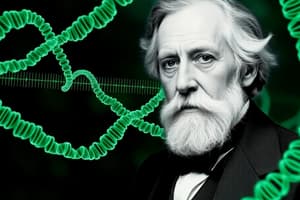Podcast
Questions and Answers
What was the primary purpose of developing dinitrofluorobenzene (DNFB) in the Sanger method?
What was the primary purpose of developing dinitrofluorobenzene (DNFB) in the Sanger method?
To react with amino groups present in proteins to form an acid-stable dinitrophenyl (DNP) derivative
What was the consequence of treating the DNP protein with acid in the Sanger method?
What was the consequence of treating the DNP protein with acid in the Sanger method?
The polypeptide backbone was broken, and the free DNP amino acid derivatives were isolated
What was the amino-terminal residue of chain A in insulin, as determined by Sanger's method?
What was the amino-terminal residue of chain A in insulin, as determined by Sanger's method?
Glycine
What was used to break the cysteine disulfide bonds in the Sanger method?
What was used to break the cysteine disulfide bonds in the Sanger method?
What was the final goal of breaking down the polypeptide chains into smaller components in the Sanger method?
What was the final goal of breaking down the polypeptide chains into smaller components in the Sanger method?
How many amino acids were found in chain A and chain B of insulin, respectively, using the Sanger method?
How many amino acids were found in chain A and chain B of insulin, respectively, using the Sanger method?
Flashcards are hidden until you start studying
Study Notes
Sanger Method for Insulin Characterization
- Developed a reagent, dinitrofluorobenzene (FDNB or DNFB), which reacts with amino groups in proteins to form acid-stable dinitrophenyl (DNP) derivatives
- Reaction of 2,4-dinitrofluorobenzene (DNFB) with polypeptides produces a DNP polypeptide
Determining Insulin Structure
- DNP protein treated with acid to break the polypeptide backbone
- Free DNP amino acid derivatives isolated and compared to standards prepared from known amino acids
- Insulin composed of two peptide chains: chain A with amino-terminal glycine and chain B with amino-terminal phenylalanine
- Chain A composed of 20 amino acids and chain B composed of 31 amino acids
Breaking Down Peptide Chains
- Acid used to cleave polypeptide backbone
- Performic acid used to break cysteine disulfide bonds
- Proteolytic enzymes used to hydrolyze polypeptide at specific sites on the chain
- Reaction products separated from each other and their sequence determined
Studying That Suits You
Use AI to generate personalized quizzes and flashcards to suit your learning preferences.





